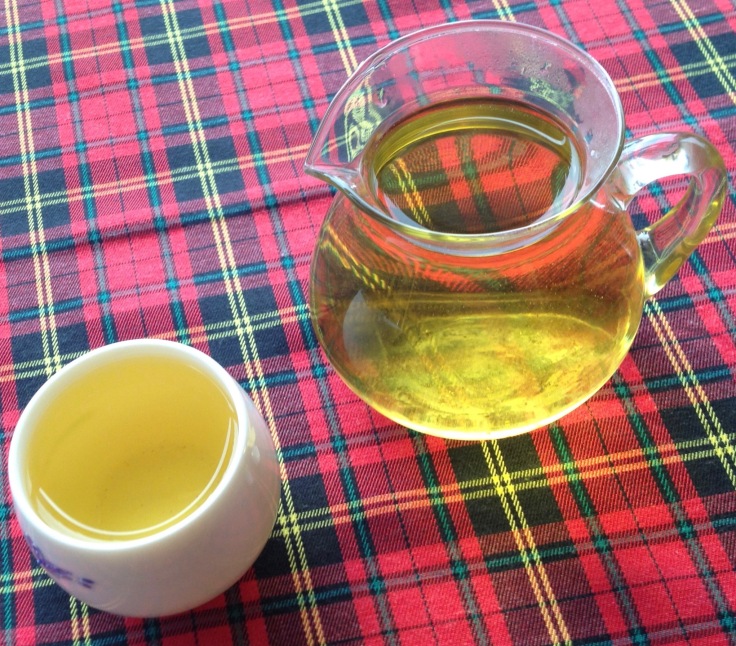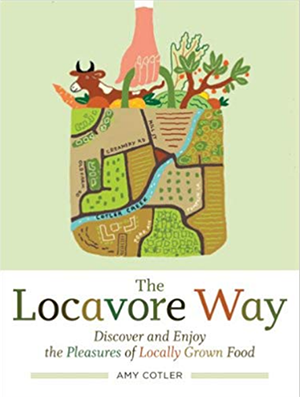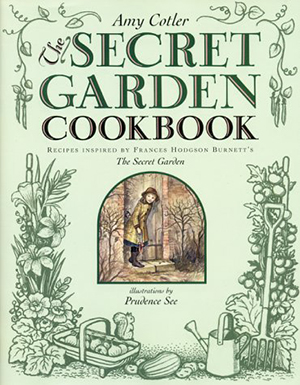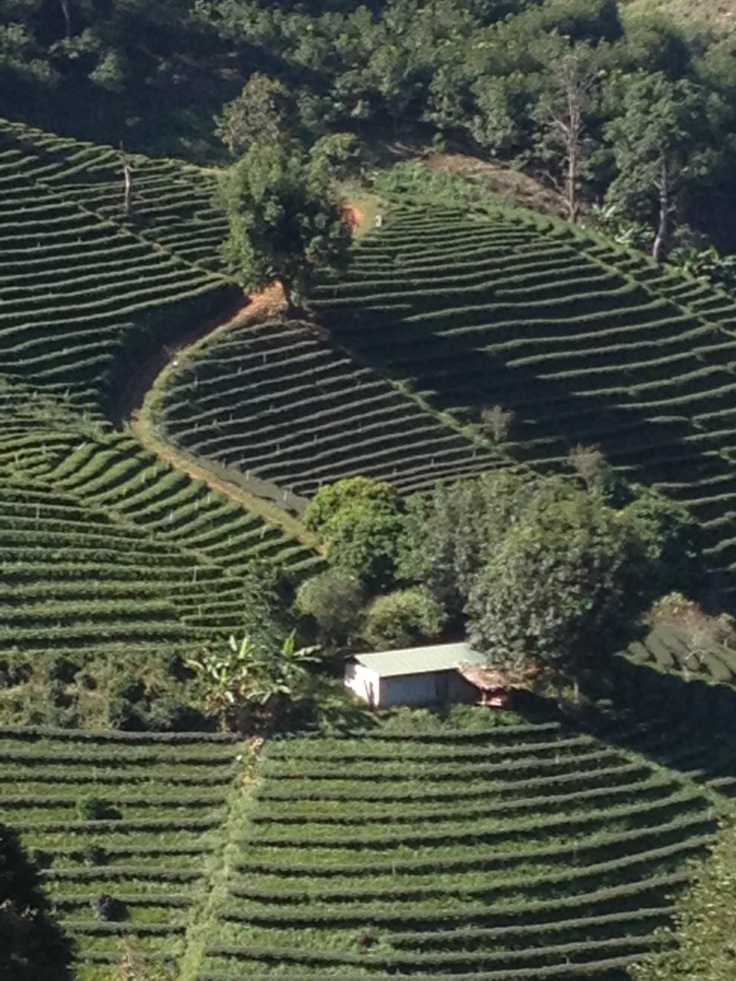
Chiang Dao to Mae Salong
She appeared out of the forest onto the road in full Akha tribal dress. Then she stepped up into the pickup truck taxi, and we immediately resumed our mountain climb. After a few miles of twists and turns, she jumped off, disappearing into the green once more. We were alone again, gripping the metal bar above to steady ourselves, heading up towards Mae Salong, a Thai-Chinese village in Northern Thailand. (More below.)
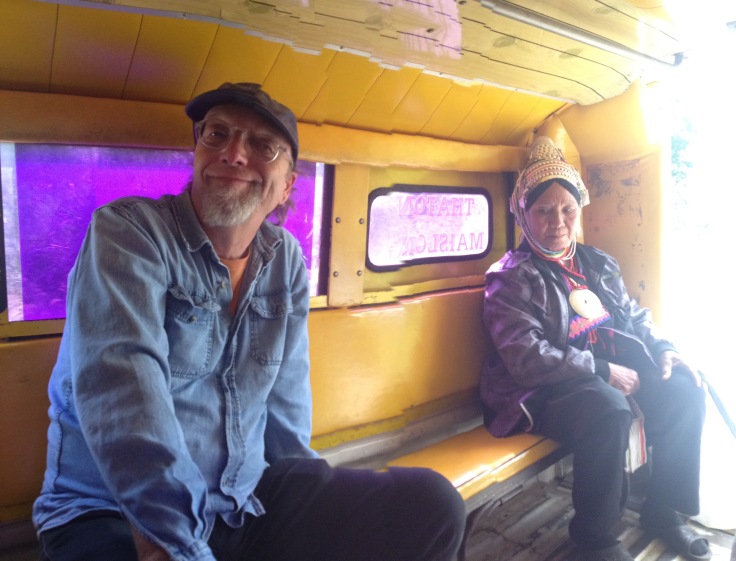
Surprisingly, my stomach was astoundingly steady after the swamp-like soup we ate at the tiny taxi station in Thaton. I’d spotted a few women stirring noodles into a fragrant broth with innards, as it turns out. While I have no objection to guts on principal, these tasted like swamp creatures from the bottom of a muddy pond and were profoundly chewy to boot. Still, the monk next to us was enjoying his. He smiled at me in his fluorescent robe, then offered me an orange. which I exchanged for one of the tiny tangerines I had on hand.
A Walk and Tea
Mae Salong, a village in Chiang Rai Province, Northern Thailand, doesn’t look like anything special. On arrival, it appeared to be a Chinese inflected Thai town with red lanterns and plenty of signs in Chinese. But walk out of town, and its landscape, which sits high above the clouds, sings.
Watch the faces of the Thai, Chinese, tourists, tribes people, some in full gear, but mostly walk, and walk. And take water, which we didn’t. Walk beyond the de rigeur plastic bags and bottles by the side of the town’s roads into the green mountainous tea country.
We brought a map from the guesthouse, which we quickly discarded, weary of looking for places specific. Although it’s what people do, Tom wanted to forgo visits to hill tribes, justified in his concerns about further exploiting them, barging into their villages uninvited. And so we kept walking, lost I suppose, past by-the-side-of-the road neighborhoods, coffee beans and tea leaves, drying in the sun.


We were thirsty and overheated with no water in sight when we wandered into a compound off the road. A woman, appeared from a large building filled with racks of drying leaves in baskets, offering us water. Revived, we continued walking the steep hills, passing bushes loaded with bright red berries. Red-stained plastic bags hung from some. And we were later told they were a variety of tea berry used for a make-up line the Thai queen favors.
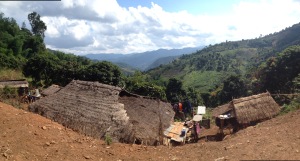
Past bamboo forests and dramatic terraced fields, we spotted the sign off the country road, where we took a turn. Suddenly we were welcomed by god-sized tea cups hovering in the air as the poured tea. Don’t you love it when you’re not looking and there it is? (See Wang Put Tan tea plantation, which is pictured above.)
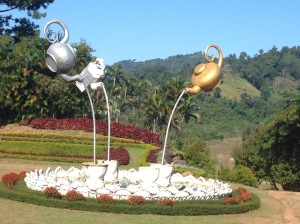
Bordered at its entrance with dried husks of corn, we settled ourselves into a tea tasting room. A young Chinese-Thai girl appeared and began pouring tea. All oolong, we tasted teas that escalated in flavor, from springlike jade, with just a touch of tannic on the tongue, to a smoky dark tea that rivaled coffee in its intensity. She “woke up” each variety of leaves with a quick first soak in hot water, introducing us to one that was lightly perfumed with local flowers. The tea master was away and my questions had to hold. So we sat drinking teas in their context, one baby cup at a time. (More below.)
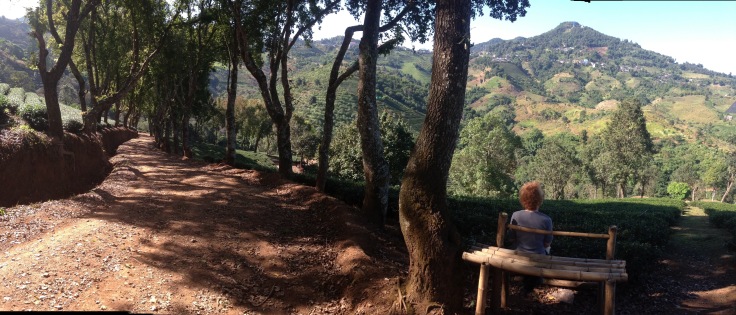
Mae Salong’s Checkered Past
What’s in a landscape and the people who shaped it? Plenty.
The majority of the Nationalist Kuomintang Army (KMT) fled China to Taiwan in 1949 after the People’s Republic of China defeated them. But the nationalist’s 5th army re-launched their futile attacks, relocating across the border to Burma. After their support faded from all, including the CIA, who used them in the Korean war, they retreated anti-communist Thailand in 1961.
As the years wore on and relations with China continued to improve with the US and Taiwan, the Mae Salong KMT lost its final support. By the 70’s, the Thai government offered the soldiers citizenship in exchange for their work against the communists and a halt in the vigorous opium trade. The town’s name was officially was changed to Santikhiri. And the region’s cash crop of opium, an embarrassment to the Thai government with its warlords and corruption, was replaced with tea and fruit trees.
The young woman serving us tea spoke of her KMT grandfather. She remembers his Yunnanese generation, reminiscing round the table about their years hiding in the jungles of Burma. And of how Taiwan forgot them.

The Market
Don’t you get the best sense of a place through its markets? Mae Salong’s daily morning market isn’t large, but its active, with Chinese, Thai and local tribes people selling and buying food. Entering, I passed drying turnip slices, hanging on strings for winter soup. The short market street was lined with breakfast soups to go, and produce, arranged on ground tarps or short tables.
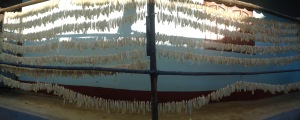
A flat-faced woman ladled a thick white bean soup jammed with noodles into my bowl for breakfast. Too thick for me — noodles AND pureed beans? And too mild, my fault: I was blown away from the hot Northern Thai food, so I ordered it bland. But, I ate and walked. And to one side a building was filled with more food in packages, and a few vendors selling roti and dough frying in thin strips.
Each morning before my market visit, I recognized half of the couple who owned Little House Guest House where we were staying. Up the small hill she climbed, plastic bags frothing with fresh produce. (More below.)

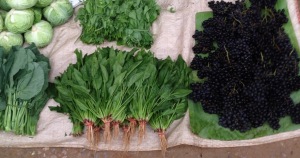
Eating Out
There’s the tasty Yunnanese Noodle Shop in town, near the place we had our laundry done. But the best food we found was the simple fresh meals at the Little Home Guest house. A stir-fry of local mushrooms and minced pork, an array of lightly cooked market vegetables, and the piece de resistance: A Yunnanese Braised Pork Leg in a rich brown sauce accompanied with steamed buns.
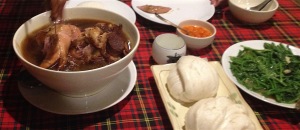
This was the same dish we’d tasted in Chiang Mai, but richer, darker. And the neutral steamed buns played yin-yang with the deeply flavored pork. Oh yes, after the fascinating but complex flavors of Northern Thai foods, these seminal dishes, centered on local foods felt like home.
Yes, there are souvenir shops and coffee shops, and interesting dried fruits. But a woman in a pink and green terry cloth turban, with an outfit to match, caught my eye. And the clouds sat comfortably below us as we walked out of town.
Sometimes it takes a small town with not much happening to make you feel like you’ve really been somewhere. (Travel tips below.)
Practical Stuff
How to get there.
We took a bus from Chiang Dao to Thaton. Then we walked up the main drag to a small yellow pickup truck taxi station for our trip to Mae Salong. The total trip was about 3-1/2 hours.
How long to stay
Most tourists take a day trip from Chiang Rai, which is fine. But our 3-day stay hit the spot. It slowed us down. After all, the best way to see a place is to stop and look.
Where we stayed
We stayed at Little Home Guest House right in town, but booked too late to have one of the much nicer looking bungalows in the back. It was about $28. There is lots of building, but even now there are other guesthouses, some cheaper, some more pricy. (Backpackers next door were staying in one that was 5 bucks a night.) There are also hotels with views, which we didn’t have. But the room was clean, the food quite good and the owner and his family extremely helpful and friendly, which trumps just about everything for us. We grew attached.
To do
There are other things to do in Mae Salong besides walk and walk, taste tea and go to the morning market, which is what we did. There is a more formal visit to the 101 tea planation. And the tourist market is on the south end of town. Better yet, there’s the Pra Boromathat Chedi (Thai style stupa) with its 719 steps up. Also, many treks to hill tribe villages can be arranged. If I were a shopper and not traveling for 7 months, I would have bought the fabulous oolong tea. There are also endless souvenirs and local preserved fruits, some familiar, some not.
To eat
The market, of course. Go first thing in the morning. The Yunnanese Noodle Shop for a decent bowl of very inexpensive soup. We had some mediocre meals, so stuck with the tasty home cooking at Little Home Guest House, as above. Home cooked. Yummy and you get to watch the town roll by.
